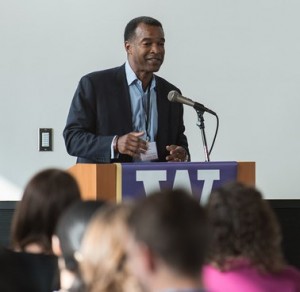Disruption, power and weak ties: All in a Day of Innovation and Entrepreneurship
 The Day of Innovation and Entrepreneurship, which took place on April 26, 2013, offered an impressive array of speakers. The all-day conference was led by Ken Denman, president and CEO of Machine Perception Technologies. He also holds the Edward V. Fritzky Chair in Leadership at the Michael G. Foster School of Business. Below are a few highlights of the knowledge shared throughout the day.
The Day of Innovation and Entrepreneurship, which took place on April 26, 2013, offered an impressive array of speakers. The all-day conference was led by Ken Denman, president and CEO of Machine Perception Technologies. He also holds the Edward V. Fritzky Chair in Leadership at the Michael G. Foster School of Business. Below are a few highlights of the knowledge shared throughout the day.
The new power: innovation and shared purpose
Nilofer Merchant, the noted innovation author, spoke about the future of social media or the “social era” as she coined it. As part of this discussion, she mentioned a shift in how we think about power. Power used to be related to how many people work for you or how much more knowledge you have than others. Now, power is your ability to get people to do amazing things. And to be powerful, you need to have a shared purpose that extends beyond yourself or your company.
She used REI as an example. Their shared purpose, the one they share with their employees, customers and the community, is getting people outdoors. “We used to think innovation is what we make,” Merchant said. “If you’re in the knowledge economy, who you are is what you make. And your ability to pull in people based on purpose is going to allow people to show up not just with the mind, but with the heart.”
She added that this makes them more committed to the cause and, therefore, willing to work tirelessly to ensure it succeeds. In turn, you’re able to engage a variety of people and have them create value, regardless of whether they work for you.
Weak ties can be strongest
Zaw Thet, co-founder and chairman of plyfe.me and HaulerDeals, was part of the Assembling Nimble and Functionally Diverse Teams panel. When discussing how to diversify your team, he referenced the paper, “The Strength of Weak Ties” by Mark S. Granovetter. As you hire employees, Thet said, you should look for people who can find diversity outside of their current network via a weak tie to another group. The motivation for this is to expand your network and therefore, diversify your staff.
Innovation versus disruption
During the discussion of the Next Big Themes, Ken Denman asked the panel to comment on the difference between innovation and disruption.
Seth Neiman of Crosspoint Venture Partners provided interesting insight on the difference between the two. He referred to innovation as “something that is of such significant value that people will change how they buy,” adding that people won’t change their behavior if there’s not an incentive. “Innovation turns into a business when the time pressure means the big company will get there too slowly, regardless of how intelligent they are,” he continued.
Disruption, according to Neiman, occurs when innovation is so powerful, it catches all the big companies off guard.
Tim Porter of Madrona Ventures made the point there are different kinds of disruption: a new technology or business model can disrupt an existing market or the creation of a whole new market can cause disruption. The latter type often provides the biggest opportunity, but is also the most difficult to anticipate. The most challenging aspect of disruption is time. Porter explained that when trying to time disruption, the biggest risk is that you’ll be too early, not too late.
Learn more about the Day of Innovation and Entrepreneurship and watch videos from all the sessions.
